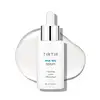What's inside
What's inside
 Key Ingredients
Key Ingredients

 Benefits
Benefits

 Concerns
Concerns

 Ingredients Side-by-side
Ingredients Side-by-side

Water
Skin ConditioningGlycolic Acid
BufferingSodium Hydroxide
BufferingGlycerin
HumectantPropanediol
SolventEthylhexyl Olivate
Skin ConditioningHydroxyethyl Acrylate/Sodium Acryloyldimethyl Taurate Copolymer
Emulsion StabilisingC13-14 Isoparaffin
EmollientC11-12 Isoparaffin
Skin ConditioningPhytic Acid
Malic Acid
BufferingMandelic Acid
AntimicrobialLactic Acid
BufferingLipase
Skin ConditioningProtease
ExfoliatingSqualane
EmollientPolyglyceryl-10 Stearate
Skin ConditioningC15-23 Alkane
SolventHydroxyacetophenone
AntioxidantPhenoxyethanol
PreservativeTricaprylin
MaskingGlyceryl Oleate
EmollientEthylhexyl Polyhydroxystearate
EmollientTetradecane
PerfumingC13-14 Alkane
SolventDecyl Glucoside
CleansingMaltodextrin
AbsorbentXanthan Gum
EmulsifyingLecithin
EmollientSclerotium Gum
Emulsion StabilisingPolyglyceryl-4 Oleate
EmulsifyingCarrageenan
Silica
AbrasiveWater, Glycolic Acid, Sodium Hydroxide, Glycerin, Propanediol, Ethylhexyl Olivate, Hydroxyethyl Acrylate/Sodium Acryloyldimethyl Taurate Copolymer, C13-14 Isoparaffin, C11-12 Isoparaffin, Phytic Acid, Malic Acid, Mandelic Acid, Lactic Acid, Lipase, Protease, Squalane, Polyglyceryl-10 Stearate, C15-23 Alkane, Hydroxyacetophenone, Phenoxyethanol, Tricaprylin, Glyceryl Oleate, Ethylhexyl Polyhydroxystearate, Tetradecane, C13-14 Alkane, Decyl Glucoside, Maltodextrin, Xanthan Gum, Lecithin, Sclerotium Gum, Polyglyceryl-4 Oleate, Carrageenan, Silica
Water
Skin ConditioningGluconolactone
Skin ConditioningC9-12 Alkane
SolventPropanediol
SolventButylene Glycol
Humectant1,2-Hexanediol
Skin ConditioningTromethamine
BufferingSodium Hydroxide
BufferingSodium Citrate
BufferingCitric Acid
BufferingEthylhexylglycerin
Skin ConditioningVaccinium Myrtillus Fruit Extract
Skin ConditioningAdenosine
Skin ConditioningDisodium EDTA
Saccharum Officinarum Extract
MoisturisingSqualane
EmollientCitrus Aurantium Dulcis Fruit Extract
MaskingCitrus Limon Fruit Extract
MaskingAcer Saccharum Extract
Skin ConditioningDioscorea Japonica Root Extract
Skin ConditioningCorchorus Olitorius Leaf Extract
Skin ConditioningNelumbo Nucifera Root Extract
Skin ConditioningHibiscus Esculentus Fruit Extract
Skin ConditioningAngelica Keiskei Extract
AntioxidantCapryloyl Salicylic Acid
ExfoliatingHippophae Rhamnoides Fruit Oil
Skin ProtectingWater, Gluconolactone, C9-12 Alkane, Propanediol, Butylene Glycol, 1,2-Hexanediol, Tromethamine, Sodium Hydroxide, Sodium Citrate, Citric Acid, Ethylhexylglycerin, Vaccinium Myrtillus Fruit Extract, Adenosine, Disodium EDTA, Saccharum Officinarum Extract, Squalane, Citrus Aurantium Dulcis Fruit Extract, Citrus Limon Fruit Extract, Acer Saccharum Extract, Dioscorea Japonica Root Extract, Corchorus Olitorius Leaf Extract, Nelumbo Nucifera Root Extract, Hibiscus Esculentus Fruit Extract, Angelica Keiskei Extract, Capryloyl Salicylic Acid, Hippophae Rhamnoides Fruit Oil
 Reviews
Reviews

Ingredients Explained
These ingredients are found in both products.
Ingredients higher up in an ingredient list are typically present in a larger amount.
Propanediol is an all-star ingredient. It softens, hydrates, and smooths the skin.
It’s often used to:
Propanediol is not likely to cause sensitivity and considered safe to use. It is derived from corn or petroleum with a clear color and no scent.
Learn more about PropanediolSodium Hydroxide is also known as lye or caustic soda. It is used to adjust the pH of products; many ingredients require a specific pH to be effective.
In small amounts, sodium hydroxide is considered safe to use. However, large amounts may cause chemical burns due to its high alkaline.
Your skin has a natural pH and acid mantle. This acid mantle helps prevent harmful bacteria from breaking through. The acid mantle also helps keep your skin hydrated.
"Alkaline" refers to a high pH level. A low pH level would be considered acidic.
Learn more about Sodium HydroxideSqualane is an emollient that helps the skin hold onto moisture. It's an oily liquid that occurs naturally in certain types of fish and plant oils.
Because squalane boosts hydration in the skin, it also comes with plenty of benefits: it is an antioxidant and can help fight free radicals and skin damage. Squalane is also found to have a detoxifying effect when applied.
Squalane comes from squalene, which occurs naturally within the sebum of our skin. It is one of the oils our skin produces to keep itself hydrated. Squalane is the hydrogenated version of squalene and has a longer shelf life.
Research shows that squalane is non-irritating (even at 100% concentration).
In general, it's a fantastic ingredient. It does a great job at hydrating the skin, and it's suitable for those with sensitive skin.
The source of squalane may impact malassezia / fungal acne. This is because olive oil derived squalane can contain impurities such as fatty acids and plant waxes. Sugarcane derived squalane is recommended for anyone with malassezia concerns.
Is squalane vegan?
This depends on the source. Squalane can be derived from both plants and animals. Most squalane used in skincare comes from plants.
Please note: the source of squalane is only known if disclosed by the brand. We recommend reaching out to the brand if you have any questions about their squalane.
Read more about squalene with an "e".
Is squalane an oil?
Squalane is often called an oil, but it’s technically not; it’s a hydrocarbon, meaning it’s only made of carbon and hydrogen, unlike true oils which are triglycerides made of fatty acids and glycerol.
The term “oil-free” isn’t regulated, so companies can define it however they want. Some exclude all oils, while others just avoid mineral oil or comedogenic oils.
While some people avoid oils thinking they cause breakouts, the right kind of oil (or oil-like ingredient like squalane) can actually help balance and hydrate your skin. It’s worth testing out simple oils or squalane to see what works best for your skin.
Learn more about SqualaneWater. It's the most common cosmetic ingredient of all. You'll usually see it at the top of ingredient lists, meaning that it makes up the largest part of the product.
So why is it so popular? Water most often acts as a solvent - this means that it helps dissolve other ingredients into the formulation.
You'll also recognize water as that liquid we all need to stay alive. If you see this, drink a glass of water. Stay hydrated!
Learn more about Water